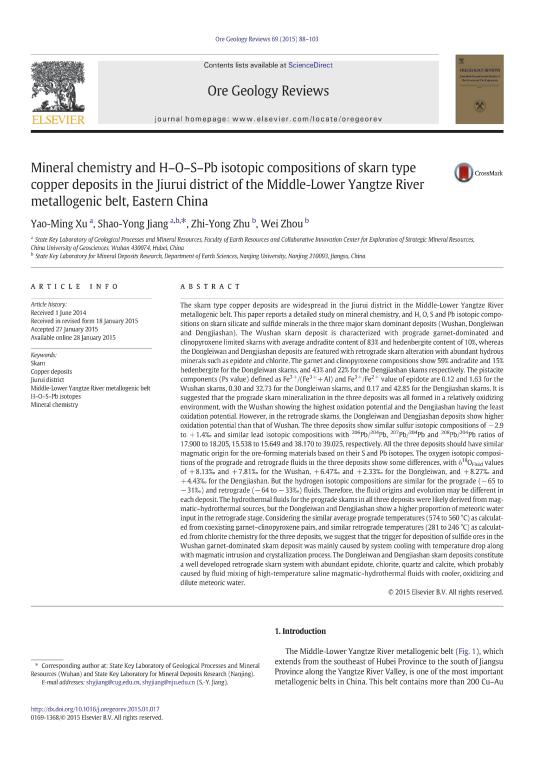

Yao-Ming Xua, Mineral chemistry and H–O–S–Pb isotopic compositions of skarn type copper deposits in the Jiurui district of the Middle-Lower Yangtze River metallogenic belt, Eastern China
The skarn type copper deposits are widespread in the Jiurui district in the Middle-Lower Yangtze River metallogenic belt. This paper reports a detailed study on mineral chemistry, and H, O, S and Pb isotopic compositions on skarn silicate and sulfide minerals in the three major skarn dominant deposits (Wushan, Dongleiwan and Dengjiashan). The Wushan skarn deposit is characterized with prograde garnet-dominated and clinopyroxene limited skarns with average andradite content of 83% and hedenbergite content of 10%, whereas the Dongleiwan and Dengjiashan deposits are featured with retrograde skarn alteration with abundant hydrous minerals such as epidote and chlorite. The garnet and clinopyroxene compositions show 59% andradite and 15% hedenbergite for the Dongleiwan skarns, and 43% and 22% for the Dengjiashan skarns respectively. The pistacite components (Ps value) defined as Fe3+/(Fe3++Al) and Fe3+/Fe2+ value of epidote are 0.12 and 1.63 for the Wushan skarns, 0.30 and 32.73 for the Dongleiwan skarns, and 0.17 and 42.85 for the Dengjiashan skarns. It is suggested that the prograde skarn mineralization in the three deposits was all formed in a relatively oxidizing environment, with the Wushan showing the highest oxidation potential and the Dengjiashan having the least oxidation potential. However, in the retrograde skarns, the Dongleiwan and Dengjiashan deposits show higher oxidation potential than that of Wushan. The three deposits show similar sulfur isotopic compositions of -2.9 to +1.4‰ and similar lead isotopic compositions with 206Pb/204Pb, 207Pb/204Pb and 208Pb/204Pb ratios of 17.900 to 18.205, 15.538 to 15.649 and 38.170 to 39.025, respectively. All the three deposits should have similar magmatic origin for the ore-forming materials based on their S and Pb isotopes. The oxygen isotopic compositions of the prograde and retrograde fluids in the three deposits show some differences, with δ18OFluid values of +8.13‰ and +7.81‰ for the Wushan, +6.47‰ and +2.33‰ for the Dongleiwan, and +8.27‰ and +4.43‰ for the Dengjiashan. But the hydrogen isotopic compositions are similar for the prograde (-65 to -31‰) and retrograde (-64 to -33‰) fluids. Therefore, the fluid origins and evolution may be different in each deposit. The hydrothermal fluids for the prograde skarns in all three deposits were likely derived from magmatic–hydrothermal sources, but the Dongleiwan and Dengjiashan show a higher proportion of meteoric water input in the retrograde stage. Considering the similar average prograde temperatures (574 to 560 °C) as calculated from coexisting garnet–clinopyroxene pairs, and similar retrograde temperatures (281 to 246 °C) as calculated from chlorite chemistry for the three deposits, we suggest that the trigger for deposition of sulfide ores in the Wushan garnet-dominated skarn deposit was mainly caused by system cooling with temperature drop along with magmatic intrusion and crystallization process. The Dongleiwan and Dengjiashan skarn deposits constitute a well developed retrograde skarn system with abundant epidote, chlorite, quartz and calcite, which probably caused by fluid mixing of high-temperature saline magmatic–hydrothermal fluids with cooler, oxidizing and dilute meteoric water.
